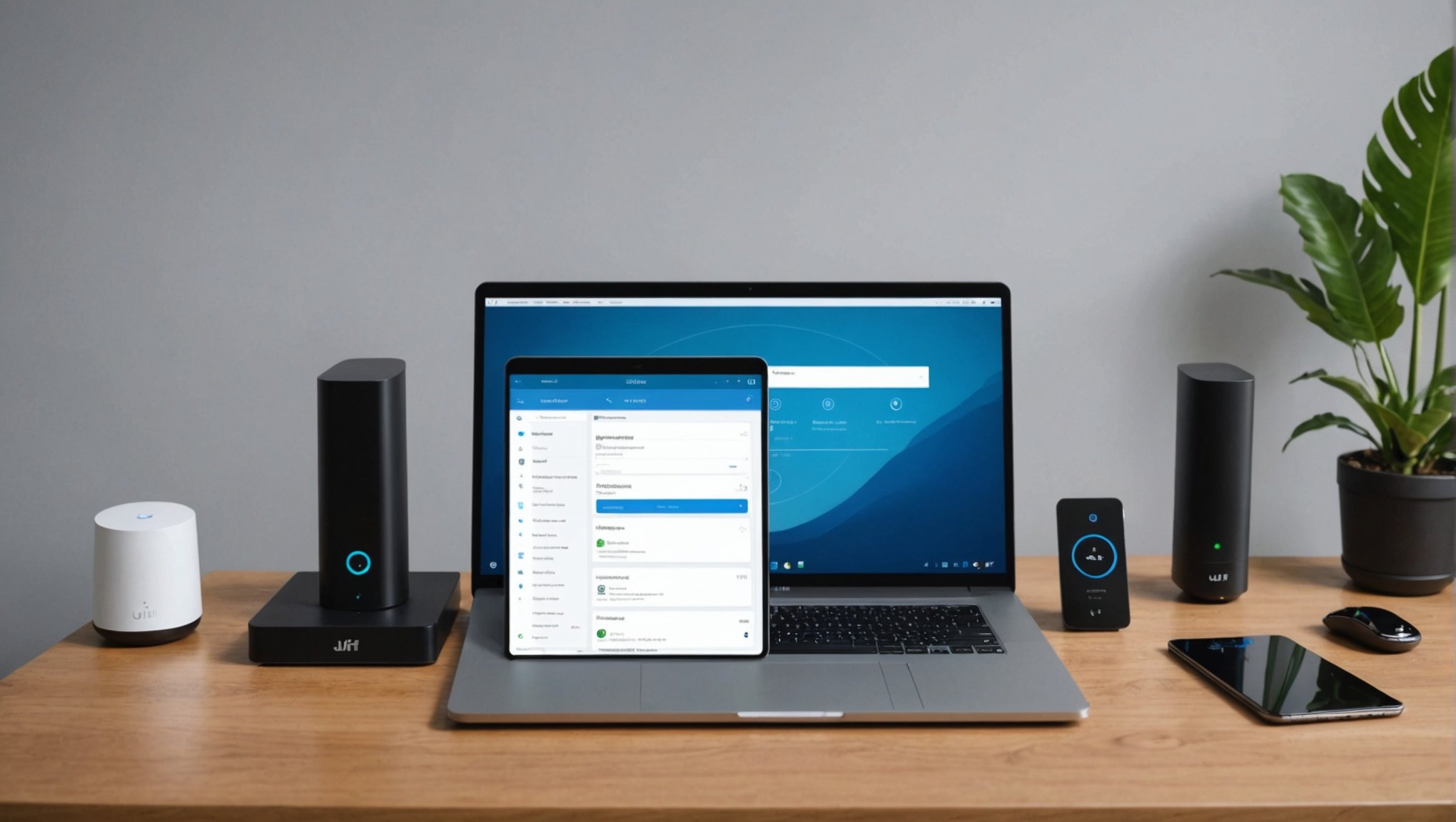Remote work offers flexibility, but ensuring a secure setup is essential. Ubiquiti’s UniFi Dream Machine combines advanced networking features with user-friendly management, making it an ideal choice. This guide details essential steps for establishing a safe remote work environment. From initial configurations to ongoing security practices, you’ll learn how to protect your data and optimize your network performance effectively. Embrace remote work’s potential without compromising safety.
Overview of Ubiquiti UniFi Dream Machine
The Ubiquiti UniFi Dream Machine (UDM) is a versatile piece of network equipment designed to simplify and enhance connectivity, especially in remote work technology setups. This all-in-one device integrates a high-performance router, a managed switch, and a security gateway, making it a comprehensive solution for both home and small office networks.
Also read : How do you optimize a Lenovo ThinkPad X1 Carbon for remote work with multiple external monitors?
One of the standout features of the Ubiquiti UniFi Dream Machine is its user-friendly interface, which allows even non-technical users to manage network settings effortlessly. This is particularly beneficial for remote work environments, where reliable and secure internet connectivity is crucial. The UDM supports seamless integration with other UniFi devices, providing scalability as network demands grow.
When compared to other network devices, the Ubiquiti UniFi Dream Machine offers a unique combination of performance and simplicity. Unlike traditional routers, it delivers enterprise-grade features without the complexity, making it an attractive option for both tech enthusiasts and everyday users. Its advanced threat management system enhances security, a vital aspect in protecting sensitive data during remote work.
In essence, the Ubiquiti UniFi Dream Machine stands out in the realm of remote work technology by offering a robust, scalable, and user-friendly network solution that meets the demands of modern connectivity.
Initial Setup and Configuration
Setting up your Ubiquiti UniFi Dream Machine begins with a straightforward unboxing and physical setup. Once you have the device out of the box, connect it to your modem using an Ethernet cable and plug it into a power source. The Dream Machine’s sleek design ensures it fits seamlessly into any environment.
Accessing the UniFi Controller
To begin the network setup, access the UniFi Controller. This intuitive platform is where you manage all aspects of your network. Simply connect your computer to the Dream Machine’s network and open a web browser. Enter the IP address provided in the user manual to access the controller interface.
Step-by-Step Network Configuration
The device configuration process is user-friendly. After logging into the UniFi Controller, follow the on-screen instructions to complete the network setup. You’ll be prompted to set up a new network, create a Wi-Fi name and password, and configure security settings. The interface guides you through each step, ensuring even those with minimal technical expertise can establish a secure and efficient network.
Completing the initial setup allows you to fully utilize the Dream Machine’s capabilities, ensuring robust connectivity and security for your remote work environment.
Securing Your Network
In today’s digital age, network security is paramount. Ensuring secure connections begins with implementing strong passwords and robust user authentication methods. These are fundamental steps in safeguarding your network against unauthorized access.
Configuring Firewall Settings
A critical aspect of network security is configuring your firewall settings. The Ubiquiti UniFi Dream Machine offers advanced firewall options, allowing you to tailor security protocols to meet your specific needs. By setting up rules and restrictions, you can control the flow of data, blocking potential threats before they infiltrate your network.
Enabling VPN for Secure Remote Access
For those working remotely, enabling a VPN (Virtual Private Network) is essential. A VPN creates a secure tunnel for data transmission, ensuring secure connections between remote users and the central network. This not only protects sensitive information from cyber threats but also maintains privacy and integrity across the network.
By focusing on these key areas, you can significantly enhance your network’s security. The combination of strong passwords, customized firewall settings, and VPN access provides a comprehensive security framework, allowing you to work confidently and securely from any location.
Optimizing Network Performance
Enhancing your network’s efficiency involves strategic network optimization techniques. To begin, configuring Quality of Service (QoS) settings is crucial. QoS allows you to prioritize traffic, ensuring essential applications like video conferencing receive adequate bandwidth. This is particularly beneficial in remote work scenarios where uninterrupted communication is vital.
Managing Bandwidth Allocation
Effective bandwidth management is key to maintaining a smooth network. Allocate bandwidth according to the needs of different applications. For instance, remote work tools such as cloud storage and collaboration platforms should have higher priority over less critical applications. This ensures that vital tasks are not disrupted by bandwidth-hogging activities.
Tips for Reducing Latency
Reducing latency can significantly enhance your network’s performance. Begin by placing your router in a central location, minimizing physical obstructions. Additionally, regularly updating your network hardware and software can prevent compatibility issues that may slow down your connection. Consider using wired connections for devices that require high-speed internet, as this reduces the interference often encountered with wireless connections.
By implementing these performance tips, you can create a robust and efficient network environment. This not only improves overall connectivity but also supports seamless remote work operations, allowing you to focus on productivity without technical interruptions.
Troubleshooting Common Issues
Navigating network issues and device problems can be daunting, but understanding common connectivity problems is the first step in effective troubleshooting. Often, issues stem from simple misconfigurations or external interferences.
Identifying Common Connectivity Problems
Start by checking for frequent network issues such as dropped connections or slow speeds. These may be caused by physical obstructions, outdated firmware, or interference from other devices. Ensure that all cables are securely connected and that the router is placed in an optimal location.
Steps to Resolve Device and Network Configuration Issues
To resolve device problems, reboot both the router and connected devices. This can often clear temporary glitches. Access the UniFi Controller to verify that all settings are correctly configured. If connectivity issues persist, consider resetting the device to factory settings.
Resources for Additional Support and Troubleshooting Guides
For ongoing troubleshooting, consult online forums and the Ubiquiti support website. These platforms offer comprehensive guides and user insights that can aid in resolving more complex issues. Engaging with the community can provide practical solutions and enhance your understanding of the device’s capabilities.
Best Practices for Remote Work Security
In the realm of remote work, adhering to best practices for cybersecurity is essential to ensure safe remote work environments. Regular updates and firmware management are critical components. Keeping your network devices and software up-to-date mitigates vulnerabilities, reducing the risk of cyberattacks. This proactive approach ensures that you benefit from the latest security patches and enhancements.
Utilizing Secure Applications and Tools
Leveraging secure applications and tools is a cornerstone of safe remote work. Opt for platforms that offer end-to-end encryption and robust authentication features. These tools protect sensitive data, ensuring it remains confidential and inaccessible to unauthorized users. Additionally, using a Virtual Private Network (VPN) adds an extra layer of security, encrypting data traffic and safeguarding privacy.
Educating Users on Phishing Threats
User education is a vital aspect of cybersecurity. Educate team members about phishing threats and safe browsing habits. Encourage vigilance when handling emails, especially those from unknown sources, and promote the use of secure passwords. Awareness campaigns and regular training sessions can empower users to identify and avoid potential security threats effectively.
Additional Resources and Support
Navigating the world of UniFi resources is essential for maximizing the potential of your Ubiquiti UniFi Dream Machine. Official Ubiquiti support channels provide comprehensive documentation, offering step-by-step guides and detailed explanations of device features. These resources are invaluable for troubleshooting and enhancing your network’s functionality.
Exploring Community Forums
Community forums serve as a vibrant hub for user support and peer advice. Engaging with fellow UniFi enthusiasts can offer practical insights and innovative solutions to common issues. These forums are a treasure trove of shared experiences and expert recommendations, making them an excellent starting point for troubleshooting and learning.
Recommended Blogs and Videos
For those seeking further learning, numerous blogs and video tutorials delve into advanced topics related to UniFi devices. These resources often provide visual demonstrations and expert tips, making complex concepts more accessible. By exploring these materials, users can deepen their understanding of network optimization and security practices.
By leveraging these UniFi resources, you can enhance your network management skills and resolve issues more effectively. Whether through official documentation or community engagement, these platforms empower users to make informed decisions and optimize their network environments.






